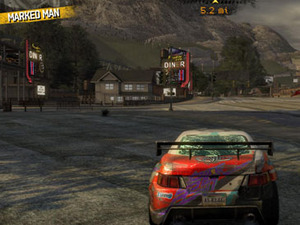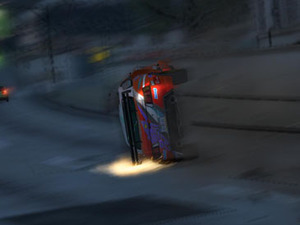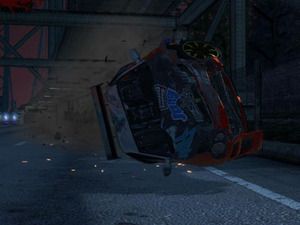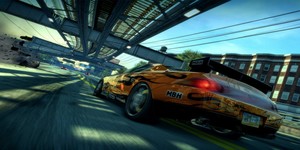
More Graphics
One of the most important parts of the graphics in Burnout Paradise, regardless of the platform, is the crumple physics of the cars – but it's also one that doesn't have any setting attached to it.The physics on the cars though are simply amazing and the way the bonnets can deform when you wrap yourself around a stationary object (like, say, a building) is really quite phenomenal. The whole body of the car can cave in on itself, windows shattering outward as the frames break the glass and spray the sidewalk with crystal shrapnel.
The fact that the cars don't explode and that no pedestrians are around to get crushed (or drivers, for that matter) is a valid point for many gamers obviously – and one that Harry raised, repeatedly. At the end of the day though, we don't mind that there's no ragdolls to be thrown around by those terrible physics and the absence of blood is something that's definitely agreeable. It's part of Burnout's appeal.
More than that though, the lack of gore is what makes the game so accessible too, keeping the rating at a family-friendly level and giving the game its guiltless, arcadey feel. Despite our love for flying bodies and sharp pointy things, we wouldn't add people into Burnout no matter what.
Environmental Detail
What this setting controls isn't exactly clear, but common sense insists that it should control the fidelity and detail used on either the close-by buildings or the far-off mountains that are nearly constantly visible in Paradise City.In reality though, the actual effect of this setting isn't at all obvious – there seems to be literally no difference between our two screenshots, save for that caused by the drifting clouds. The far-off mountains, the close-up buildings, the amount of clouds in the sky and the detail on miscellaneous items like streetlights and ramps? All the same, no matter the setting. The textures, numbers and polygon-counts of all these items seem constant.
Which isn't to say that this setting doesn't do anything though – it must. It's just that we can't pinpoint what different it makes based on the screenshots we've taken or our days playing the game. Our suggestion is to stick the Environmental Detail up to High unless you have a particularly low framerate or more observant eyes than ours.
Motion Blur
Motion Blur is dreadfully important to getting the most out of Burnout Paradise, we'll just say it. With Motion Blur turned off you just can't get the full feeling of speed that the game offers, whether you're playing from the bumper cam or the default third person camera. See what we mean below.Again, the difference here is pretty non-existent. There's literally no change between the settings...no, OK, we're joking. Badly. There's a huge difference and it's so obvious we don't need to write about it.
As we mentioned before though, having Motion Blur turned on is massively important to the game though, whether you're racing or crashing. It's weird that there's a continued interest in crispness for most gamers when it comes to graphics, when really the best thing that Burnout Paradise does is blur things up and make things look all messy.
The importance and visual impact of the setting makes us recommend you keep it on if you possibly can then – playing the game without it is like playing the game naked. Against your grandma.

MSI MPG Velox 100R Chassis Review
October 14 2021 | 15:04













Want to comment? Please log in.